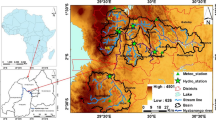Abstract
Snowmelt-runoff modelling in a mountainous basin is perceived as difficult due to the complexity of simulation. Theoretically, the snowmelt process should be influenced by temperature changes. It is still controversial as how to incorporate the temperature changes into the snowmelt-runoff model in a mountainous basin. This paper presents the results of a study in the North Fork American River basin where the snowmelt-runoff mechanism is modelled by relating the temperature changes to the elevation band in the basin. In this study, a distributed hydrologic model is used to explore the orographic effects on the snowmelt-runoff using the snowfall-snowmelt routine in Soil and Water Assessment Tool (SWAT). Three parameters, namely maximum snowmelt factor, minimum snowmelt factor, and snowpack temperature lag were analysed during the simulation. The model was validated using streamflow data from October 1, 1991 to September 30, 1994 with and without considering the elevation band. The result of this study suggests that the snowmelt-runoff model associated with the elevation band better represents the snowmelt-runoff mechanism in terms of Nash–Sutcliffe coefficient (E NS ), R 2, and Root Mean Square Error (RMSE).





Similar content being viewed by others
References
Arnold J G, Srinivasan R, Muttiah R S and Williams J R 1998 Large area hydrologic modelling and assessment – Part I: Model development; J. Am. Water Resour. Assoc. 34(1) 73–89.
Dettinger M D, Cayan D R, Meyer M K and Jeton A E 2004 Simulated hydrologic responses to climate variations and change in the Merced, Carson and American River basins, Sierra Nevada, California, 1900–1999; Climate Change 62 283–317.
Fontaine T A, Cruickshank T S, Arnold J G and Hotchkiss R H 2002 Development of snowfall-snowmelt routine for mountainous terrain for the Soil and Water Assessment Tool (SWAT); J. Hydrol. 262(1–4) 209–223.
Hartman M D, Baron J S, Lammers R B, Cline D W, Band L E, Liston G E and Tague C 1999 Simulations of snow distribution and hydrology in a mountain basin; Water Resour. Res. 35(5) 1587–1603.
Huber W C and Dickinson R E 1988 Storm Water Management Model; Version 4: User’s Manual, Athens, GA: US Environmental Protection Agency.
Hunsaker T C, Whitaker W T and Bales C R 2012 Snowmelt runoff and water yield along elevation and temperature gradients in California’s Southern Sierra, Nevada; J. Am. Water Resour. Assoc. 48 667–678.
Jeton A E, Dettinger M D and Smith J L 1996 Potential effect of climate change on streamflow, eastern and western slopes of the Sierra Nevada, California and Nevada; US Geological Survey, Water Resources Investigations Report 95–4260 44p.
Kang K and Merwade V 2011 Development and application of storage-release based distributed hydrologic modeling using GIS; J. Hydrol. 403 1–13.
King K W, Arnold J G and Bingner R L 1999 Comparison of green-ampt and curve number methods on Goodwin Creek Watershed using SWAT; Trans. Am. Soc. Agr. Biol. Eng. 42(4) 919–925.
Kult J, Choi W and Keuser A 2012 Snowmelt runoff modelling: Limitations and potential for mitigating water disputes;; J. Hydrol. 430–431 179–181.
Luce C H, Tarboton D G and Cooley K R 1998 Subgrid parameterization of snow distribution for an energy and mass balance snow cover model; International Conference on Snow Hydrology, October 1998, Brownsville, VT.
Marks D, Dozier J and Davis R E 1992 Climate and energy exchange at the snow surface in the alpine region of the Sierra Nevada. 1. Meteorological measurement and monitoring; Water Resour. Res. 28(11) 3029–3042.
Martinec J, Rango A and Roberts R 2008 In: Snowmelt Runoff Model (SRM) User’s Manual (eds) Gomez-Landesa E and Bleiweiss M P; New Mexico State University, Las Cruces, NM.
Nash J E and Sutcliffe J V 1970 River flow forecasting through conceptual models: Part 1. A discussion of principles; J. Hydrol. 10(3) 282–290.
Neitsch S L, Arnold J G, Kiniry J R, Williams J R and King K W 2002 Soil and Water Assessment Tool – Theoretical Documentation (version 2000). Temple, Texas: Grassland, Soil and Water Research Laboratory, Agricultural Research Service, Blackland Research Center, Texas Agricultural Experiment Station.
Neitsch S L, Arnold J G, Kiniry J R, Williams J R and King K W 2005 Soil and Water Assessment Tool - Theoretical Documentation (version 2005). College Station, TX: Texas Water Resource Institute.
Tahir A A, Chevallier P, Arnaud Y, Neppel L and Ahmad B 2011 Modeling snowmelt-runoff under climate scenarios in the Hunza River basin, Karakoram Range, northern Pakistan; J. Hydrol. 409(1–2) 104–117.
Wang X and Melesse A M 2005 Evaluation of the SWAT model’s snowmelt hydrology in a northwestern Minnesota watershed; Trans. ASABE 48(4) 1359–1376.
Westerstrom G 1984 Snowmelt runoff from Porsön residential area, Luleå, Sweden; 3rd International Conference on Urban Storm Drainage, Goteborg, Sweden: Chalmers University, pp. 315–323.
Whitaker A, Alila Y, Beckers J and Toews D 2002 Evaluating peak flow sensitivity to clear-cutting in different elevation bands of a snowmelt-dominated mountainous catchement; Water Resour. Res. 38(9) 111–1117.
Acknowledgements
This work was supported by the National Research Foundation of Korea (NRF) grant funded by the Korea government (MSIP) (No.2011-0030040).
Author information
Authors and Affiliations
Corresponding author
Rights and permissions
About this article
Cite this article
Kang, K., Lee, J.H. Hydrologic modelling of the effect of snowmelt and temperature on a mountainous watershed. J Earth Syst Sci 123, 705–713 (2014). https://doi.org/10.1007/s12040-014-0423-2
Received:
Revised:
Accepted:
Published:
Issue Date:
DOI: https://doi.org/10.1007/s12040-014-0423-2




